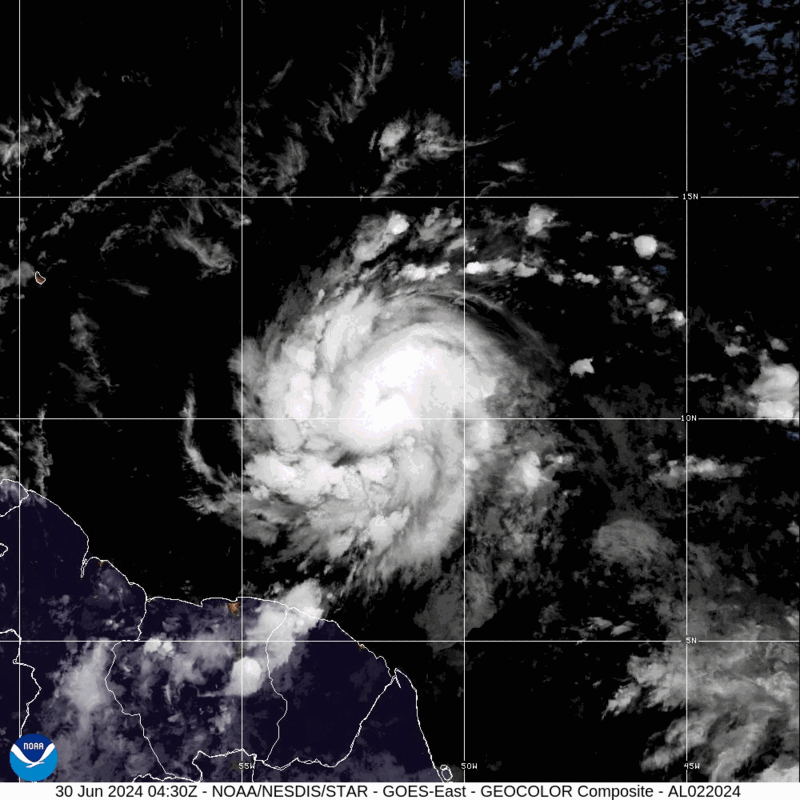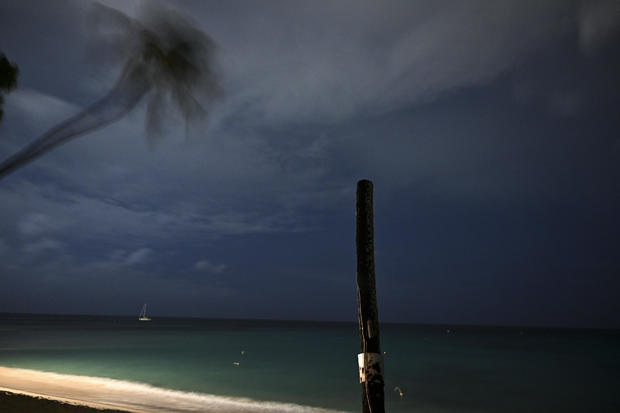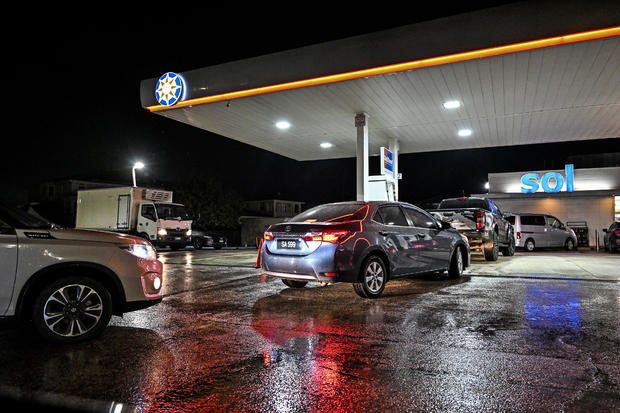Hurricane Beryl makes landfall as "extremely dangerous" Category 4 storm lashing Caribbean islands
Hurricane Beryl made landfall Monday as a powerful Category 4 storm on the Caribbean island of Carriacou in Grenada, as forecasters warned that the first major hurricane of the Atlantic season would bring "extremely dangerous" conditions.
The National Hurricane Center said "life-threatening winds and dangerous storm surge" were beginning in the Windward Islands as the eyewall of Beryl —a powerful Category 4 — moved over Carriacou Island. Beryl was expected to move across the southeastern and central Caribbean Monday through Wednesday.
Hurricane warnings were in effect for Barbados, Grenada, Tobago and St. Vincent and the Grenadines, and Jamaica was under a hurricane watch. Tropical storm warnings were in place for Martinique, Trinidad and St. Lucia, and tropical storm warnings were effective in parts of the Dominican Republic and Haiti.

A hurricane warning is ordered when hurricane conditions are imminent and "preparations to protect life and property should be rushed to completion" within the warning area, according to the hurricane center, while a hurricane watch indicates that conditions are possible within 48 hours. A tropical storm warning means that tropical storm conditions are expected in the warning area within 36 hours.
As of 11 a.m., Beryl was centered about 35 miles northeast of Grenada and 15 miles east-southeast of Carriacou Island, tracking west-northwest at 20 mph with maximum sustained winds of 140 mph. It is a compact storm, with hurricane-force winds extending 30 miles from its center. An hour earlier, a weather station in at Grantley Adams International Airport in Barbados had already reported sustained winds of 52 mph and gusts of 69 mph, according to the hurricane center.
Residents in the Grenadine Islands and Carriacou Islands were advised not to leave their shelters as forecasters expected winds to increase rapidly within the eyewall of the hurricane.
"Remain in place through the passage of these life-threatening conditions and do not venture out in the eye of the storm," the center said.
Beryl was expected to pass just south of Barbados early Monday and then head into the Caribbean Sea as a major hurricane on a path toward Jamaica. It was forecast to weaken by midweek, but still remain a hurricane while heading toward Mexico.
Historic hurricane
It took Beryl only 42 hours to strengthen from a tropical depression to a major hurricane — a feat accomplished only six other times in Atlantic hurricane history, and with Sept. 1 as the earliest date, according to hurricane expert Sam Lillo.
Beryl became the third Category 3 hurricane ever recorded in the Atlantic in June, following Audrey in 1957 and Alma in 1966, hurricane specialist and storm surge expert Michael Lowry said.
"Beryl is an extremely dangerous and rare hurricane for this time of year in this area," he told the Associated Press in a phone interview. "Unusual is an understatement. Beryl is already a historic hurricane and it hasn't struck yet."

Hurricane Ivan in 2004 was the last strongest hurricane to hit the southeast Caribbean, causing catastrophic damage in Grenada as a Category 3 storm.
"So this is a serious threat, a very serious threat," Lowry said of Beryl.
Beryl is the second named storm in what is predicted to be a busy hurricane season, which runs from June 1 to Nov. 30 in the Atlantic. Last week, Tropical Storm Alberto brought torrential flooding to portions of southern Texas and northeastern Mexico. It was responsible for at least four deaths in the Mexican states of Nuevo Leon and Veracruz.
According to CBS News weather producer David Parkinson, Beryl is the farthest east a hurricane has formed in June, and one of only two to do so east of the Caribbean, with the other instance occurring in 1933. Parkinson expects Beryl to remain south of Jamaica, and forecasts that any U.S. impacts are still at least eight days away.
Warm waters are fueling Beryl, with ocean heat content in the deep Atlantic the highest on record for this time of year, according to Brian McNoldy, University of Miami tropical meteorology researcher.
Forecasters warned of a life-threatening storm surge of up to 9 feet in areas where Beryl will make landfall, with up to 6 inches of rain for Barbados and nearby islands.
Bracing for the storm

Long lines formed at gas stations and grocery stores in Barbados and other islands as people rushed to prepare for a storm that rapidly intensified from a tropical storm with 35 mph winds on Friday to a Category 1 hurricane on Saturday.
"We need to be ready," Barbadian Prime Minister Mia Mottley said in a public address late Friday. "You and I know when these things happen, it is better to plan for the worst and pray for the best."
She noted that thousands of people were in Barbados Saturday for the Twenty20 World Cup cricket final, with India beating South Africa on Saturday in the capital of Bridgetown. It is considered cricket's biggest event.
Meanwhile, St. Vincent and the Grenadines Prime Minister Ralph Gonsalves said in a public address Saturday that shelters will open Sunday evening as he urged people to prepare. He ordered officials to refuel government vehicles and asked grocery stores and gas stations to stay open later before the storm.
"Please take this very seriously and prepare yourselves," said Gonsalves. "This is a terrible hurricane."
Caribbean leaders were preparing not only for Beryl, but for a cluster of thunderstorms trailing the hurricane that have a 70% chance of becoming a tropical depression.
"Do not let your guard down," Mottley said.
According to the National Hurricane Center, the season's first hurricane usually forms in early to mid-August, which makes Beryl unusual for having reached hurricane strength so early in the summer. In a report released last month, the National Oceanic and Atmospheric Administration predicted an "above average" hurricane season with 17 to 25 storms, 8 to 13 hurricanes and 4 to 7 major hurricanes of category 3 or higher. An average Atlantic hurricane season produces 14 named storms, seven of them hurricanes and three major hurricanes.
A tropical storm is named when a tropical cyclone has maximum sustained winds of 39 to 73 mph, while a hurricane is defined as a tropical cyclone with maximum sustained winds greater than 74 mph.
- In:
- Caribbean
- Hurricane
Disclaimer: The copyright of this article belongs to the original author. Reposting this article is solely for the purpose of information dissemination and does not constitute any investment advice. If there is any infringement, please contact us immediately. We will make corrections or deletions as necessary. Thank you.



